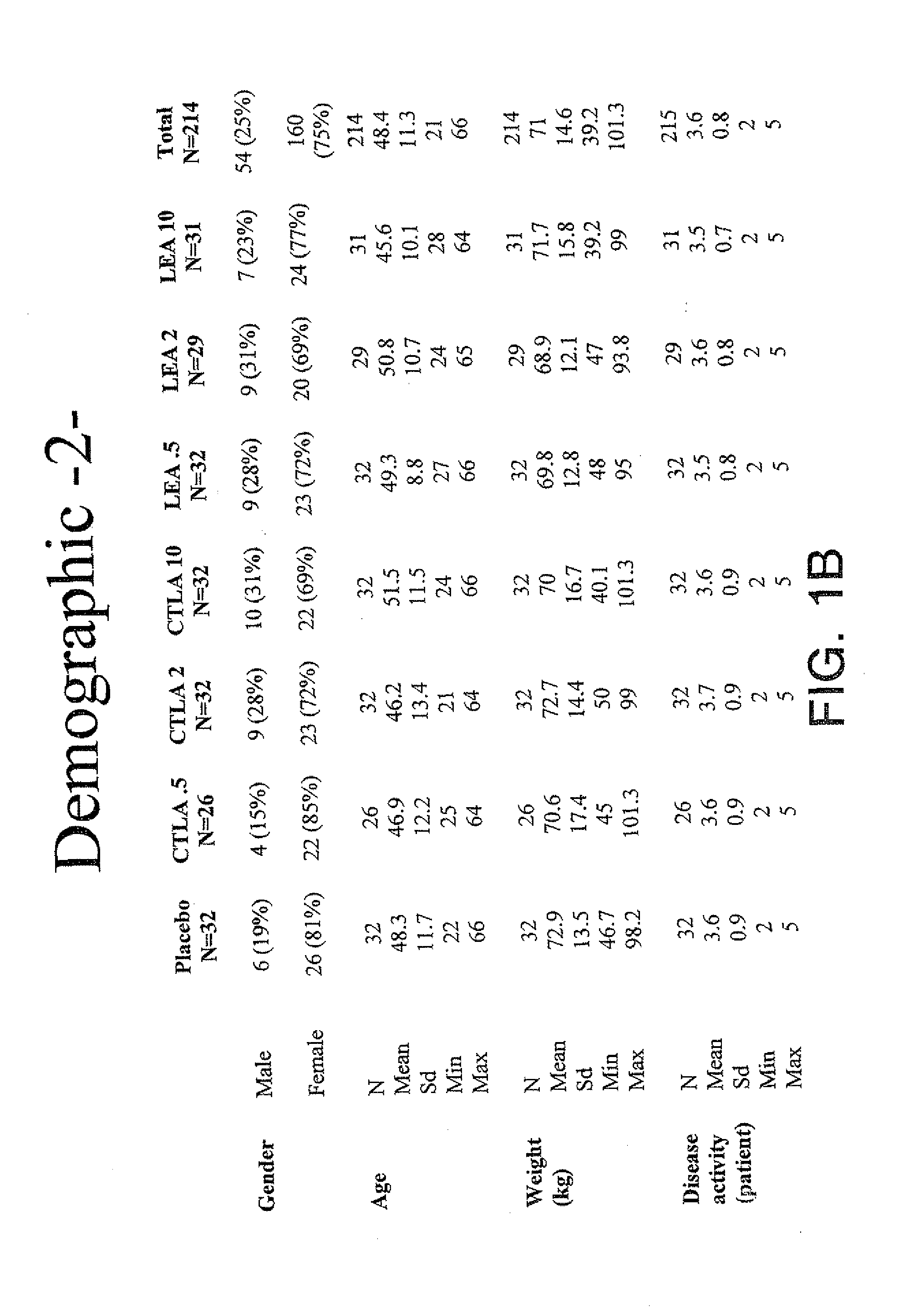Method for treating an autoimmune disease using a soluble ctla4 molecule and a dmard or nsaid
a technology of soluble ctla4 and dmard or nsaid, which is applied in the field of immunodeficiency syndrome, can solve the problems of increasing the risk of infection and oncogenesis, unable to cure rheumatic diseases, and long-term us
- Summary
- Abstract
- Description
- Claims
- Application Information
AI Technical Summary
Benefits of technology
Problems solved by technology
Method used
Image
Examples
example 1
[0313]The following provides a description of the methods used to generate the nucleotide sequences encoding the CTLA4 molecules of the invention.
[0314]A CTLA4Ig encoding plasmid was first constructed, and shown to express CTLA4Ig molecules as described in U.S. Pat. Nos. 5,434,131, 5,885,579 and 5,851,795. Then single-site mutant molecules (e.g., L104EIg) were generated from the CTLA4Ig encoding sequence, expressed and tested for binding kinetics for various B7 molecules. The L104 μg nucleotide sequence (as included in the sequence shown in FIG. 18) was used as a template to generate the double-site CTLA4 mutant sequences (as included in the sequences shown in FIGS. 19-22) which were expressed as proteins and tested for binding kinetics. The double-site CTLA4 mutant sequences include: L104EA29YIg, L104EA29LIg, L104EA29TIg, and L104EA29WIg. Triple-site mutants were also generated.
CTLA4Ig Construction
[0315]A genetic construct encoding CTLA4Ig comprising the extracellular domain of CTL...
example 2
[0325]The following example provides a description of the screening methods used to identify the single- and double-site mutant CTLA polypeptides, expressed from the constructs described in Example 1, that exhibited a higher binding avidity for B7 molecules, compared to non-mutated CTLA4Ig molecules.
[0326]Current in vitro and in vivo studies indicate that CTLA4Ig by itself is unable to completely block the priming of antigen specific activated T cells. In vitro studies with CTLA4Ig and either monoclonal antibody specific for CD80 or CD86 measuring inhibition of T cell proliferation indicate that anti-CD80 monoclonal antibody did not augment CTLA4Ig inhibition. However, anti-CD86 monoclonal antibody did augment the inhibition, indicating that CTLA4Ig was not as effective at blocking CD86 interactions. These data support earlier findings by Linsley et al. (Immunity, (1994), 1:793-801) showing inhibition of CD80-mediated cellular responses required approximately 100 fold lower CTLA4Ig ...
example 3
[0358]The following provides a description of phase II clinical studies of human patients administered soluble CTLA4 mutant molecule L104EA29YIg (also known as LEA29Y or LEA) or CTLA4Ig, to relieve at least one symptom associated with rheumatoid arthritis, including reducing: joint swelling, joint tenderness, inflammation, morning stiffness, and pain. The CTLA4Ig molecule used herein begins with methionine at position +1 (or alternatively with alanine at position −1) and ends with lysine at position +357 as shown in FIG. 24. DNA encoding an embodiment of the CTLA4Ig molecule has been deposited as ATCC 68629. The L104EA29YIg molecule used herein begins with methionine at position +1 (or alternatively with alanine at position −1) and ends with lysine at position +357 as shown in FIG. 19. DNA encoding an embodiment of the L104EA29YIg molecule has been deposited as ATCC PTA 2104.
[0359]Additionally, the following provides a description of human patients administered L104EA29YIg or CTLA4I...
PUM
 Login to View More
Login to View More Abstract
Description
Claims
Application Information
 Login to View More
Login to View More - R&D
- Intellectual Property
- Life Sciences
- Materials
- Tech Scout
- Unparalleled Data Quality
- Higher Quality Content
- 60% Fewer Hallucinations
Browse by: Latest US Patents, China's latest patents, Technical Efficacy Thesaurus, Application Domain, Technology Topic, Popular Technical Reports.
© 2025 PatSnap. All rights reserved.Legal|Privacy policy|Modern Slavery Act Transparency Statement|Sitemap|About US| Contact US: help@patsnap.com



